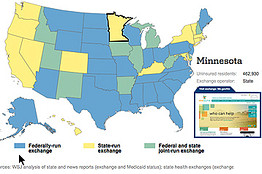Obamacare, Results and Employer-Based Benefits
< < Go Back
by John R. Graham,
Now that we have over one full year of ObamaCare under our belts, a mystery is unfolding: What is happening to employer-based benefits? Data from different sources convey widely different messages, but until we solve this mystery, it is difficult to predict the political future of President Obama’s troubled health reform law.
The puzzle is obscured by the media’s focus on topline figures, which indicate significant increases in the number of insured people, including millions added to Medicaid, the joint state-federal program for low-income households. In truth, it is inappropriate to categorize Medicaid dependents as “insured” — for the same reason it is inappropriate to consider jobless people who receive cash welfare benefits as “employed.” The fiscal difference between people who depend on government benefits and those who do not is one of kind, not of degree.
But how should we classify consumers covered through the ObamaCare exchanges? Are they government dependents or not? The issue is tricky.
Although almost nine of 10 people enrolled in the exchanges pay premiums discounted by the tax credits the federal government gives health insurers, they are not fully dependent on government welfare.
For those who are net taxpayers, we cannot say whether they are paying more or less taxes than they would pay without ObamaCare — not unless we know whether the healthcare law caused them to lose (tax-exempt) employer-based benefits.
Before Congress passed the Affordable Care Act in 2010, many experts anticipated that it would lead to a hemorrhaging of employer-based benefits, as businesses and their employees figured out that going into ObamaCare’s exchanges would reduce their net tax burden. Unfortunately, the data so far are inconsistent and even contradictory.
– In March, the RAND Corporation published survey results that show the number of adults under 65 years old with employer-based health coverage rose by 8 million since the ObamaCare exchange rollout.
-One report that contradicts the RAND report comes from Goldman Sachs. According to Scott Gottlieb of the American Enterprise Institute, the investment banking giant estimates that small employers dropped 2.2 million beneficiaries from coverage, a reduction of 13 percent from 2013. So much for optimism.
…
So what may we conclude about ObamaCare’s results to date? For reasons yet unknown, the most certain outcome that the president’s healthcare reform has caused immense confusion about the numbers of uninsured. That in itself is reason for Congress to revisit this controversial and unpopular law.
More From NCPA:




